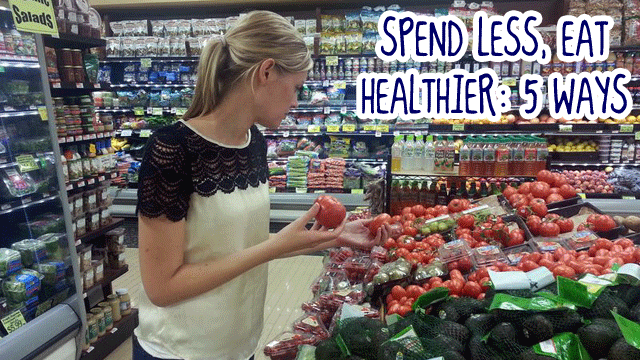By Bridget Sandorford
A college diet notoriously consists of ramen noodles and pizza — because those foods are cheap, and many of us don’t have the money to buy gourmet, organic foods. Now that you’re cooking on your own, though, you’re establishing the cooking (and eating) habits that can stick with you for years afterward. If you think the Freshman 15 is ugly, wait til you meet the 20something 30.
The upside? You don’t have to be a trust fund baby to afford to eat well. Here are a few tips for eating healthy on a college budget:
Hello, Whole Foods (No, Not the Grocery Store!)
It may not seem like it at first, but often, buying the ingredients to make your food will cost a whole lot less than buying the pre-packaged meal from the freezer section or ordering it from a fast-food joint. If you buy those ingredients when they are in season, you’ll save even more. When foods don’t have to be preserved and shipped halfway around the world to make it to your table, they carry less overhead and can be sold at lower costs.
You can find out what’s growing each season here, though another great rule of thumb is to shop the perimeter of the grocery store and look for produce that’s on sale. Sale items usually signify that there’s a ton of that fruit or vegetable growing right now (like tomatoes in July or August). Then search for recipes — or invest in a seasonally organized cookbook, like the Working Class Foodies Cookbook or Cooking in the Moment — using it. (Psst—you can search by ingredient on Collegiate Cook using the search bar!)
Fiber Isn’t Just for Your Digestion
Fiber is the nutrient that helps you to feel full quicker so that you eat less yet also feel more satisfied. Fruits and veggies are full of fiber, yet they may not always be the least expensive options. Try to build meals around staples like rice and beans that are very inexpensive and also very high in fiber. You can sauté a few high fiber vegetables – like broccoli, green peas or corn – to mix in or serve as a side, just to add flavor and variety.
Get Local
Your local chain grocer oversees a vast network of stores, suppliers and shippers. All of these expenses get passed along to you. However, when you shop at a farmer’s market or other local market, you buy the foods direct. Therefore, you don’t get charged those typical overhead costs and you lower your overall grocery bill (just watch out for “artisanal” vendors that can charge triple the cost for heirloom veggies you may not actually need or want). You’ll also be buying foods that are grown locally and in season, which means that you will be shopping for fresh, healthy foods.
Play Gardener (Yes, Even in a Dorm Room!)
It may seem impossible to grow your own food when you’re holed up in classes all day — and you don’t have a backyard. However, there are a number of crops you can grow in containers with sunlight from the window that don’t require a lot of maintenance. Some simple beginner’s crops include lettuce, spinach, tomatoes and herbs, like basil and oregano.
You don’t have to grow your whole menu. Just growing a few of these items can help you to cut back on what you have to spend at the market. Plus, you’ll have fresh, healthy food that you know hasn’t been treated with insecticides and other harmful chemicals.
Host a Different Kind of Party
We’re talking potlucks. You’ll only have to make one dish (or maybe even just an appetizer or dessert), yet you’ll be able to feast on a variety of foods that your friends brought. If you’re hosting, you may even get to keep the leftovers, which could feed you for days afterward.
About the Author:
Bridget Sandorford is a freelance blog and culinary writer, where recently she’s been researching online culinary training. In her spare time, she enjoys biking, painting and working on her first cookbook.

